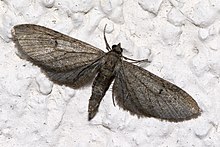| Eupithecia | |
|---|---|

| |
| Eupithecia innotata | |
| Scientific classification | |
| Domain: | Eukaryota |
| Kingdom: | Animalia |
| Phylum: | Arthropoda |
| Class: | Insecta |
| Order: | Lepidoptera |
| Family: | Geometridae |
| Tribe: | Eupitheciini |
| Genus: | Eupithecia Curtis, 1825[1] |
| Synonyms[2] | |
| |
Eupithecia is the largest genus of moths of the family Geometridae,[3] and the namesake and type genus of tribe Eupitheciini. Species in the genus are, like those of other genera in the tribe, commonly known as pugs.[4] The genus is highly speciose, with over 1400 species, and members of the genus are present in most of the world with exception of Australasia.[3] Roughly a quarter of described Eupithecia species occur in the Neotropical realm, where they have an especially high species diversity in the montane rain forests of the Andes.[5] The genus includes a few agricultural pest species, such as the currant pug moth, Eupithecia assimilata, which is a pest on hops,[6] and the cloaked pug moth, Eupithecia abietaria, which is a cone pest in spruce seed orchards.[7]
Adult specimens of Eupithecia are typically small, often between 12 and 35 mm, with muted colours, and display a large amount of uniformity between species.[3] As a result, identification of a specimen as part of genus Eupithecia is generally easy, but identifying the exact species is difficult and often reliant on examination of the dissected genitals.[3] Most species share a characteristic resting pose in which the forewings are held flat at a right angle to the body—that is, the costal margins of both forewings form a more-or-less horizontal line—while the hindwings are largely covered by the forewings.[8] They are generally nocturnal.[3]

Of the species where the larval behaviour is known, most feed from the flowers and seeds of their food plants rather than the foliage.[3] Many species have a very specific food plant. The larvae of all but one[9] of the endemic species of Eupithecia from Hawaii are ambush predators of a wide variety of insects and spiders.[10] These ambush predators have raptorial legs, with which they grab prey that comes into contact with their hind end.[10]
- ^ a b Cite error: The named reference
Mironov-2003was invoked but never defined (see the help page). - ^ Cite error: The named reference
funetwas invoked but never defined (see the help page). - ^ a b c d e f Cite error: The named reference
Mironov-Galsworthy-2013was invoked but never defined (see the help page). - ^ Cite error: The named reference
Plant-2014was invoked but never defined (see the help page). - ^ Cite error: The named reference
Vargas-2021was invoked but never defined (see the help page). - ^ Cite error: The named reference
Campbell-2007was invoked but never defined (see the help page). - ^ Cite error: The named reference
Wang-2014was invoked but never defined (see the help page). - ^ Cite error: The named reference
BugGuidewas invoked but never defined (see the help page). - ^ Cite error: The named reference
Hembry-2021was invoked but never defined (see the help page). - ^ a b Cite error: The named reference
Montgomery-1983was invoked but never defined (see the help page).